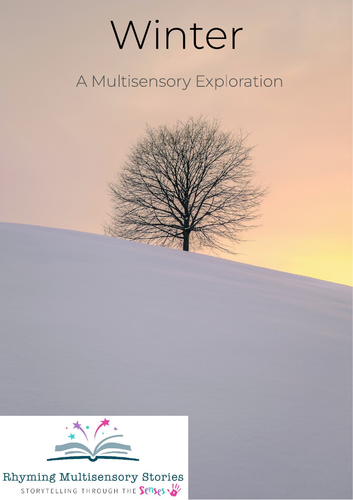

Explore the sights, sounds, smells, tastes and textures of Winter with this fully resourced, step by step multisensory story
‘I woke up this morning and to my delight
A carpet of snow had fell in the night
I put on my gloves, scarf and a hat
And followed the tracks of a bird and a cat’
A multisensory story is told using sensory stimuli (props).
The story props are low budget, everyday items found around the home, garden, outdoor areas and in the classroom.
Table of Contents
Introduction
Health & Safety
The Benefits of Multisensory Storytelling
How to tell a Multisensory Story
Story Props
Winter- Full Story
Winter- Fully Resourced, Step-by Step Story
Sensory Snow
Winter Themed Sensory Bin
Winter Clothes Exploration
Frozen Nature Blocks
Expanding Water Experiment
Feed the Birds
Let’s Explore…Robins
Winter Sensory Walk
Magic Marshmallows
Make a Snow Globe
Snowmen
Snowflakes
Rainbow ice Sculpture
Frozen Winter Flower Globe
Winter Food Tasting
Snowflake Decorations
Winter Sensory Ideas & Inspiration
This story includes over 50 themed, sensory extension activities that link to the EYFS Framework and areas of the KS1 National Curriculum making them the perfect resource for Special Education (aged 3-19) EYFS, Mainstream Primary, Speech & Language and EAL students.
What are the Benefits of Multisensory Storytelling?
-
Storytelling creates a bond between the storyteller and the story explorer enhancing and enriching experiences.
-
Rhyming Multisensory Stories connect the individual to literature, culture and topic in a fun and engaging way.
-
The stories form a base on which to scaffold learning enabling the student to work on personal goals and individual targets.
-
The activities in the stories are designed to promote communication skills: (eye contact, listening, shared attention & language development), self-confidence & well-being (trying out new ideas & skills, practicing self-care & independence and enjoying achievement), self-awareness: (asking for ‘help’, ‘again’ and ‘more’), present opportunities to explore cause & effect and build anticipation skills, promote physical development: (fine & gross motor skills), build knowledge about the environment & the world around us, to engage in scientific experimentation and mathematical concepts and to develop social & emotional skills: (turn-taking & sharing and teamwork).
-
The sensory stimuli (story props) are a tool for the story explorer to explore and express their likes, dislikes and sensory preferences and to have the opportunity to make choices.
This information can be used to identify motivators or items to calm and individual when anxious, tired or stressed, identify triggers, (some you may wish to avoid, others to work on building tolerance through desensitisation in a safe and therapeutic environment) and used in the writing of care plans to enhance areas daily life.
Your questions, queries, comments and feedback are always welcome!
Something went wrong, please try again later.
This resource hasn't been reviewed yet
To ensure quality for our reviews, only customers who have purchased this resource can review it
Report this resourceto let us know if it violates our terms and conditions.
Our customer service team will review your report and will be in touch.